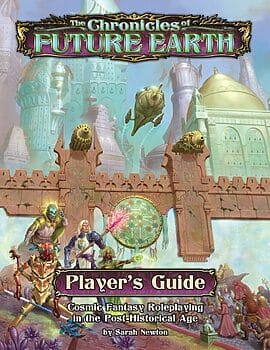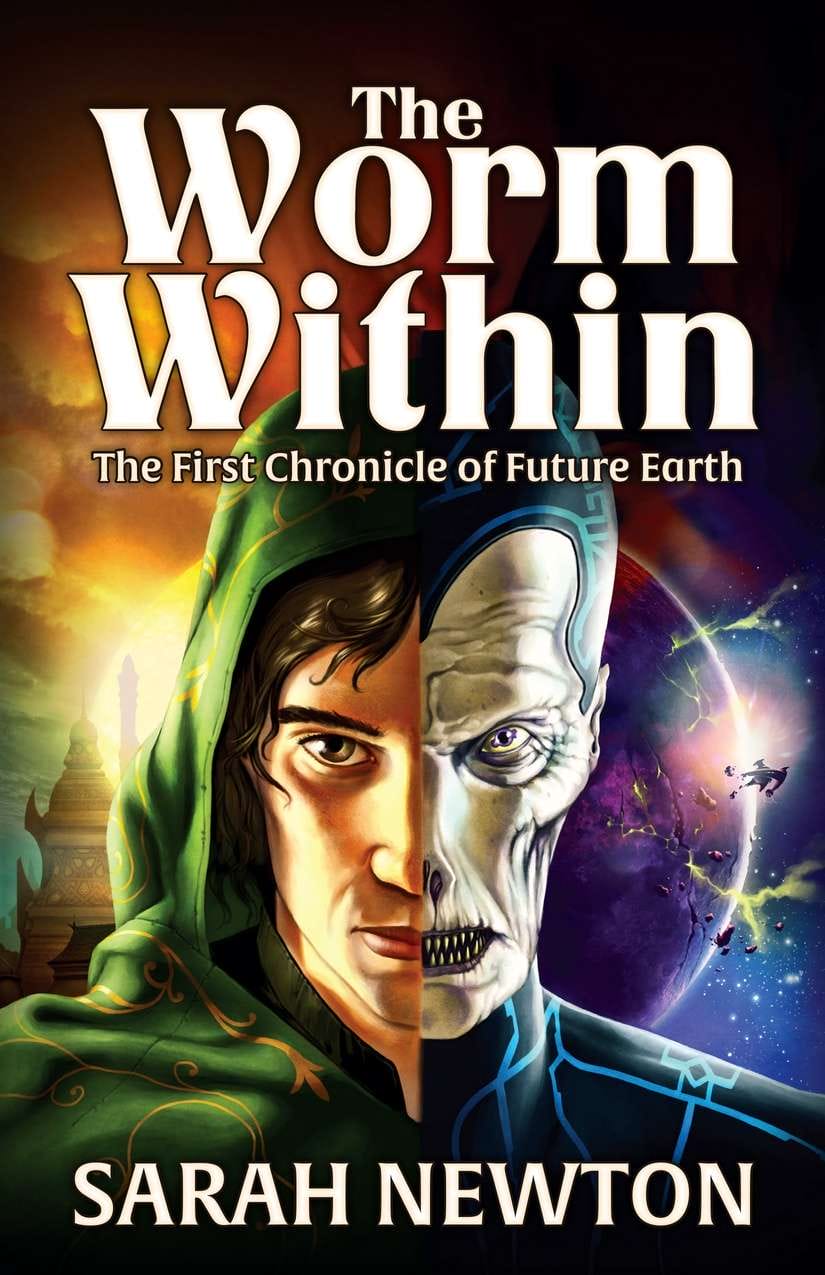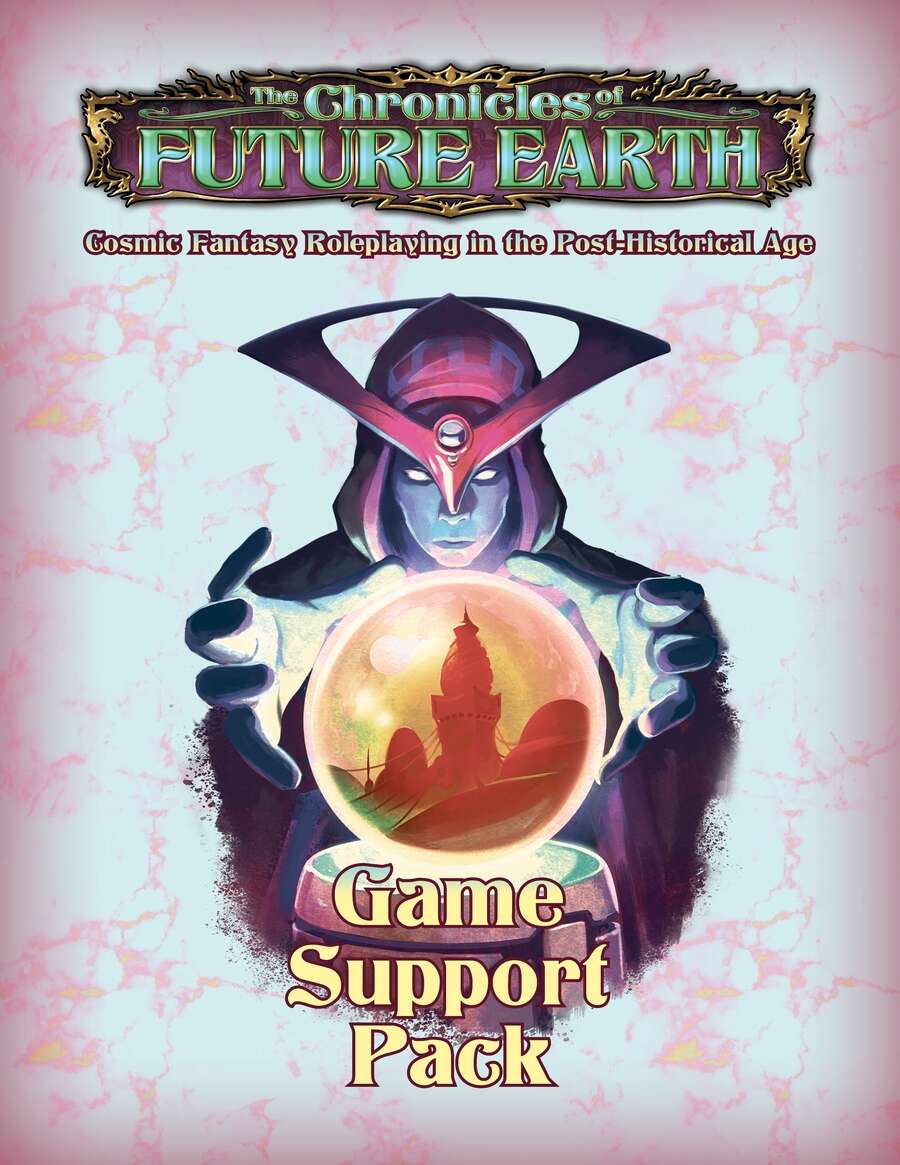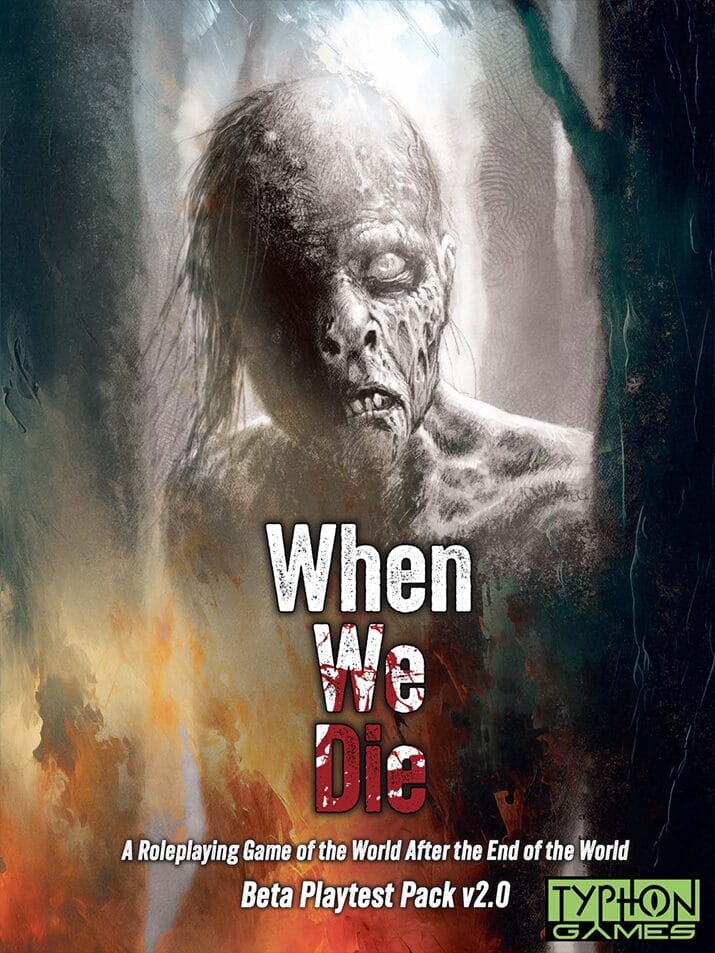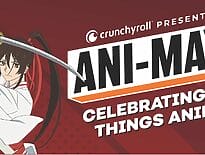In this interview, Sarah Newton talks about The Chronicles of Future Earth, a cosmic fantasy TTRPG.
Interestingly, Sarah also recently joined Typhon Games, the new British publisher formed by tabletop veterans who have been pushing into zombies!
For readers who don’t know, please introduce The Chronicles of Future Earth? What is it?
Well, The Chronicles of Future Earth is subtitled “Cosmic Fantasy Roleplaying in the Post-Historical Age”. It’s a post-transhuman, science-fantasy roleplaying game set in the far, far future of our own planet Earth, perhaps 70,000AD, when the world is in the throes of an ice age, the sea levels are much lower, and the locus of civilisation is in the north of what’s currently Africa. The game feels like fantasy, the gameplay is filled with fantasy tropes, but with a particular spin; a once hyper-advanced civilisation has fallen in the long-forgotten prehistoric past, and now the lands of the Springtide Civilisations, populated by human beings, divergent hominids, and even alien beings, worship the Gods of the Great Compact, who impose an intense conservatism to preserve the world from the Great Hegemonist, a dominating, diabolic power who they can only resist together. The Great Hegemonist, and its servitors the Reaver Gods, try constantly to destroy the Springtide Civilisations and reduce humankind to desperate slavery.
In concrete terms, it’s a game in three volumes—Player’s Guide, Chronicler’s Guide, and World Guide—which uses a system we’re calling Cosmic Fate, which is a gritty, lethal, and at the same time epic version of the Fate Core system. We’ve just released the Player’s Guide, which basically contains all the core rules, magic and character creation, and will be releasing the Chronicler’s Guide in the autumn and the World Guide (called The Guide to Future Earth) in the fourth quarter this year.
Do The Chronicles of Future Earth have a theme or message? What’s the game about?
Yes, I guess they do! The Springtide Civilisations are basically stagnant, asleep, and nothing has changed for thousands of years. There has been so much history that the word literally has lost all meaning; history per se is impossible to study, and more has been forgotten than is known. Individual human lives seem meaningless; against such a weight of the past, it seems impossible to make a difference. So the world’s societies actively resist change; innovation is frowned upon, if not forbidden, as is questioning the status quo. People are convinced they have the “right ways” to do things. But those ways aren’t working any more, the forces of domination and entropy are gaining the upper hand, and unless people get real smart, real quick, it’s pretty much the end of the world. The game is about what you do in a world that needs to wake up, but doesn’t even know that it’s asleep.
Thematically, The Chronicles of Future Earth is “cosmic fantasy”. It’s about epic dooms, summoning demons, dealing with weird and ancient technologies, dimension-hopping, and saving the universe. It’s about a lost and mysterious past, about strange and deadly secrets. Imagine a Möbius book of Clarke Ashton Smith stories mixed in with lashings of Moorcockian Stormbringery and Hawkmooniana, drop in a dash of Byzantium, ancient China, Vance’s Dying Earth and a bit of Gene Wolfe and M John Harrison’s Pastel City, and you’ll have the vibe.
The game has been out for a few months now. In this short time, have there been any common questions, trends, or observations from tabletop gamers that you’ve noticed?
So far the reaction has been great—people are digging the Player’s Guide, enjoying the deep background and gorgeous artwork by Jason Juta and friends. People are asking questions about the Venerable Autocracy of Sakara, the oldest of the Springtide Civilisations, in which the Player’s Guide is mostly set. I first wrote a slim supplement for BRP in 2009 also called The Chronicles of Future Earth, so some people have wondered why the new game doesn’t use that system, but instead uses a new (and extremely customised) version of Fate Core (for an answer to that, read on!).Finally, because the 2018 Kickstarter for the Chronicles was pretty much blown to high heaven by personal tragedy in 2019 which took me several years to pull myself back from, people have been almost universally very happy the Chronicles are coming out, and have been sending lots of messages of friendship and support! It’s been quite the epic journey to this point!
Okay, the game has been out for a few months, but its origins and journey go back far further. Please take us through the voyage. In many ways, it’s incredible that an idea can persist for so long despite such hardships.
I guess like all creative ideas, it’s an obsession. I tapped into the Chronicles of Future Earth many, many years ago, somewhere in the mid-1980s. I was immensely inspired by the vibe of the artwork of Bruce Pennington, especially his covers for the New English Library edition of classic science-fiction and science-fantasy masterworks. As a youngling, I dreamed of a role-playing game set in a cosmos illustrated by Bruce, and begin to devise that cosmos. I’ve always been a keen history and pop science buff, fascinated by deep time and the strange posthuman beings we may evolve into, and also staggered by the implications of climate change and just how our current societal system is ideologically unable (even unwilling) to deal with it; all those ideas have stayed with me all my life, and have fed into the development of the Chronicles of Future Earth. I even wrote to Bruce maybe 15 years ago to tell him of my massive fangirlery and all about the Chronicles, and he very kindly wrote back giving me his blessing. That was an awesome moment.
I first put pen to paper to write an RPG setting for the Chronicles of Future Earth in about 1999. At the time, I’d just got hold of the 3rd edition of D&D, and wrote it for that. I played a bunch of sessions with my then-husband Chris, the lovely Paco Jaen of GMS Magazine (hi Paco! That was a quarter century ago, mon ami!), and a chap called Ed, and began to explore the strange lands of Future Earth. But pretty quickly I ran up against issues where the rules I was using couldn’t easily handle the gameplay, the depth and variety of cultures, societies, and organisations, I wanted. And so I switched to using BRP in the early 2000s, inspired by the way games like RuneQuest, Stormbringer, and Hawkmoon had enabled character interactions with cults, demons, weird technologies, and, ultimately, had permitted a certain type of character transcendence, which really interested me. When the Big Gold Book came out in 2008 or so, I got my first ever RPG credit by sending Jason Durall reams and reams of proofing notes on the pre-release copy I’d bought, and from that got inspired to propose The Chronicles of Future Earth to Jason, Charlie Krank, and editor William Jones. We had a lot of wordcount and budget constraints, but I’m still proud of that book—it captured a lot about the world vibe and gameplay.
But it was about that time I discovered Fate, and wrote the first edition of Mindjammer for Chris Birch’s Starblazer Adventures. That changed everything for me: the Fate Fractal, and the way it effortlessly allows your game sessions to scale, so that you can play individual characters, organisations, legions, temples, even whole societies, starships, planets, even civilisations, and all in an elegant and interwoven way, just blew me away. At that point I knew I had the key to a very powerful machine—one that could do justice to my whole conception of the Chronicles of Future Earth. I started to write a Fate version in 2012, but ended up publishing the 2nd edition of Mindjammer—The Roleplaying Game first. But I kept at it, and was ready for Kickstarting in 2018. Even when my life exploded in 2019, I kept working on the manuscript, and last year finally realised I needed to drastically restructure, but otherwise was in a position to finally release the game!
So, yes, it’s been an epic voyage to this point! But I’ve found Future Earth to be fascinating, inspiring; it’s a cauldron of ideas, many of which resonate in our own society. When you write a roleplaying game, it’s always essential to understand that, on aggregate, your audience is always smarter than you—more intelligent, more expert, more knowledgeable—so you have to do your best to be honest, tell your own truth, offer your own ideas, and hope people will dig them. I did that with Mindjammer, and am constantly inspired by the New Commonality of Humankind; and I do that with Future Earth. It keeps my brain firing, and I hope it will fire yours too!
Fate’s a much older gaming system than 5e, BRP, the Year Zero Engine, or any of the newly opened and licenced sets of mechanics out there. Why did you stick with Fate Core for The Chronicles of Future Earth?
I’ve partly given my reasons above, but in an abstract way. So let’s get concrete. In most RPGs, character development is linear. An individual character becomes more awesome as they “level up”, develop their skills, what have you. That’s the paradigm that the vast majority of RPGs use; even video RPGs have inherited it. It’s so ubiquitous, people may be tempted to think it’s “the way things naturally are”.
But it’s not. I don’t even think that paradigm mirrors reality all that well. I’ve been alive cough for more than half a century, and I’ve learned how to do a lot of stuff. I’ve also forgotten how to do a lot of stuff. But I don’t exist in isolation; I exist at my own personal nexus of multiple networks of relationships with other people. With family, friends, companies, organisations. I’m a writer of RPGs, but also of fiction; I’m a publisher; I write songs, and also play guitar and violin; I’m in a rock band; I’m a wife, a stepmother, a daughter; a friend to many different groups of people. All those networks are part of who I am; and the way I act in my social milieu—the skills and influence I can bring to bear in a given situation—depend just as much on those relationships as on my own personal skills and abilities.
In my view, that’s what human development looks like. I didn’t have all those networks when I was a child; I’ve built them laboriously over my life, and they’re in constant flux.
In Fate, you have an RPG system which can represent character advancement exactly in that way. It’s amazingly powerful, and in the Cosmic Fate system which powers The Chronicles of Future Earth, we really bring it to the fore of the game experience. It informs everything. So, as your character advances, yes, he or she develops skills, advances in some, maybe falls back in others, prioritises their abilities based on their current milieu of activity. Let’s call that “vertical advancement”—you get “higher level” as you advance. But, also, characters expand into social networks and relationships with the world, the people and organisations around them. Your character literally gets some of the skills and abilities of whole organisations like legions, temples, guilds, on his or her character sheet, as well as the abilities of summoned demons, sidekicks, and more. That “horizontal advancement” means your character gradually gains the ability to act in wider and more varied arenas of action. Your high priest can now get his temple to declare an entire city anathema! Or your legion general can march 10,000 troops to occupy an entire province. Now that’s power! That’s character advancement! And the Cosmic Fate rules allow you to seamlessly model how your character’s dice rolls affect legions, cities, even societies and other organisations and communities. This stuff is gameable.
I started this path of rules exploration with Mindjammer; you’ll see many earlier version of these rules concepts in Mindjammer 2nd edition. In The Chronicles of Future Earth, I’ve moved them another step forward, winkling out of the Fate Core rules some really cool ways of doing things that, in all honesty, I’m not sure too many other RPG systems even address.
What are your top tips for GMs getting into Fate Core?
Fate has a reputation for being a bit weird. I don’t think that’s true at all. It has some innovative rules and a lot of possibilities for game play that go beyond old school sensitivities, but at heart it’s a very traditional roleplaying game. You roll dice, add a skill level and maybe some other modifiers, and compare that to a difficulty class. Take it from there.
Of course, Fate also offers a lot of other bells and whistles to do cool stuff, but it’s not hard to grok the basics. So, if you’re a GM and fancy trying out the system, just go for it! The Chronicles of Future Earth Player’s Guide has a free 30-page preview at DriveThruRPG, including the whole of the basic rules chapter. Also, Typhon Games is just releasing an updated version of the Chronicles of Future Earth quickstart and introductory adventure called The Swallower of Souls. It’s completely free for download! The whole rules are about 20 pages, plus there’s a multi-session adventure and a bunch of pregenerated characters, maps, world background, and more. All gorgeously illustrated by Jason Juta and friends. Grab yourself a copy of that, have a read, maybe take it for a spin! And join us on RPG.net, Facebook, or on our Typhon Games Discord if you have questions or just want to hang out!
Does that mean Typhon Games will be embracing Fate Core?
I guess so! Typhon will be publishing the whole Chronicles of Future Earth line, as well as Mindjammer, so Fate Core, in our own “Cosmic Fate” incarnation, will be one of the systems we publish and support. I firmly believe there’s still a lot of untapped potential and scope for deep exploration in the Fate Core system, and with these two games I hope to carry on doing so under the Typhon banner!
Can you tell us a bit more about the Mindjammer Press and Typhon Games merger? Are The Chronicles of Future Earth one of the reasons it happened?
Yes, definitely. I’d worked with Garry Harper, Jason Juta, and Graham Spearing a lot during the Mindjammer Press years, but after my annus horribilis of 2019 and its aftermath, I kind of fell apart, and Garry and Jason founded Typhon Games to carry on the awesome work they’d been doing. But they kept supporting me and Mindjammer Press as I pulled myself back together, and when I finally got back on my feet in 2023, they invited me over to join them at Typhon as a co-director. It was a wonderfully generous offer, and a total no-brainer; for me, too, it’s a fresh start, with new perspectives, and so I’m now part of a cracking team of dynamic and ambitious professionals who I know and respect, and we’re going to produce some very cool stuff I hope people will love, and I warmly invite everyone who loved Mindjammer Press to come over and join us in this new venture. What’s not to like?!
What, if anything, is planned for the future of The Chronicles of Future Earth?
It’s our plan to develop The Chronicles of Future Earth into a roleplaying game line as extensive as Mindjammer, and for the two games to continue in parallel courses into the future, with lots of new publications. Right now, my focus is on producing the “complete game” for the Chronicles. Back in the Kickstarter days, I envisaged that as a single (if slightly hefty) tome; but since then I’ve realised it makes more sense as three separate volumes: the Player’s Guide (core rules, magic, character creation, introduction to the setting), available right now; the Chronicler’s Guide (campaign secrets, bestiary, artefacts, treasures, communities, and lots of cosmic mind-blowing dimensional stuff), available this autumn; and the Guide to Future Earth (maps, gazetteers, but also loads of information on temples, legions, guilds, sorcery schools, and other communities which characters can develop relationships with as part of their “horizontal advancement”—see above), available towards the end of the year.
Once the three core books are done, we’ll be releasing The Korudav Campaign, a detailed episodic campaign and adventure, and Wormhollow Vale, a massive scenario pack. We’ll also be doing several other Kickstarter-related releases of support material and other goodies.
That constitutes the “initial release” of the Chronicles of Future Earth—everything that’s currently on the table. After that—well, that’s where it gets wild… I have a quarter century of material ready to rumble… Watch this space! 😉
Oh, and I almost forgot: The Swallower of Souls quickstart and introductory adventure should be releasing in updated format pretty much around the time this interview is published. Check it out!
What about you and Typhon Games? Is there anything in the pipeline that you can tell us about?
The lovely thing about Typhon Games is that it’s not just me. Garry, Jason, and Graham all have projects they’re passionate about, and which I’ll be involved in one way or another (usually getting involved with writing and / or editing). The one thing that’s very much in the pipeline for this year is WHEN WE DIE, a brand new RPG using a new ruleset called the Covenant System. It’s Garry and Jason’s baby, but I’ve come on board to shepherd the game to publication, taking over much of the editing and writing. As its simplest, it’s a Zombie Survival Horror RPG—but it’s so much more than that. You know me, I’m a sucker for games of ideas, and this is one, in spades, really plugging into the existential fears of displacement, climate change, ecosystem collapse, pandemics and AI apocalypses, and all that good stuff. There’s an open playtest beta rules doc downloadable right now on DriveThru, including an introductory adventure, and we’re currently aiming to Kickstart the game once the core rules are written (and pretty much laid out) this autumn. It’s going to go some unexpected places, and I hope you’ll join us!
Quick Links
- The Chronicles of Future Earth Player’s Guide.
- The Chronicles of Future Earth – Game Support Pack (free).
- The Worm Within.
- When We Die – Beta Playtest.
